Exploring Sketchbook Apps: A Digital Canvas for Creatives
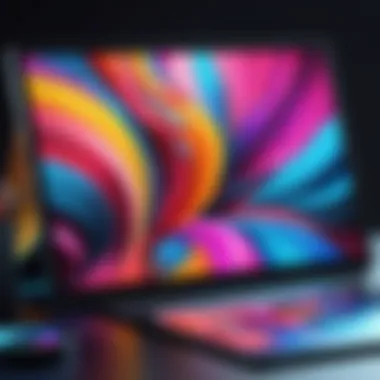
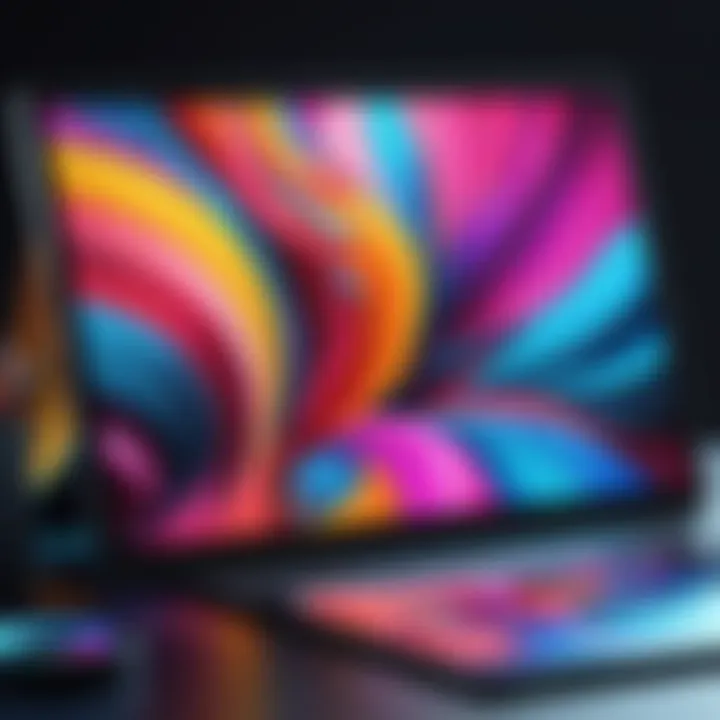
Intro
In the realm of creativity, technology plays an integral role in shaping how artists and designers bring their visions to life. Sketchbook apps have emerged as essential tools, bridging the gap between traditional artistic methods and the digital landscape. As the demand for versatility and convenience grows among creators, these applications offer a myriad of features tailored to diverse user needs. In this exploration, we will delve into the key aspects of sketchbook apps, examining their technology, design, and the profound impact they have on the modern artistic process.
Overview of the Technology
Sketchbook apps are built on versatile technological frameworks that empower users to create with ease. They offer various specifications that cater to both novices and seasoned professionals. Typically, these apps are compatible with tablets and stylus inputs, allowing for a more natural drawing experience.
Key Specifications
Most sketchbook apps support high-resolution canvases, enabling detailed work and refined artistry. The ability to layer images and drawings is fundamental to creating complex and dynamic artworks. Additionally, real-time responsiveness ensures that every stroke reflects the artist's intent without lag, which is crucial for a seamless creative flow.
Unique Selling Points
One significant advantage of sketchbook apps is their extensive toolsets. Users have access to an impressive variety of brushes, pens, and colors, often customizable to suit their specific styles. Furthermore, many apps include cloud integration to save work in real-time, making it easier to collaborate and share. The flexibility to export files in multiple formats also enhances usability across different platforms.
"Digital sketching apps allow for an unparalleled level of experimentation, offering tools that can be adjusted on-the-fly, a feature seldom achievable with traditional mediums."
Design and Build Quality
When considering sketchbook apps, the design and user experience are pivotal. An intuitive interface significantly influences how quickly creators can adapt and engage with the app.
Material Used
While sketchbook apps exist in a digital format, their foundations are built on user-centric design principles. These applications employ a minimalistic interface, ensuring users are not overwhelmed by unnecessary elements.
Ergonomics and Usability
Usability can vary considerably among sketchbook apps. Many prioritize ergonomics by offering customizable toolbars, allowing users to arrange their workspace for optimal comfort. This approach is particularly vital for professional artists who may spend hours on end working on detailed projects.
Prelims to Sketchbook Apps
In the digital age, sketchbook apps represent a significant shift in the way artists and designers create. These applications have transformed traditional sketching practices into a digital format, allowing for a greater degree of flexibility and innovation. As technology progresses, the importance of understanding these tools becomes more pronounced for both novice and experienced creators. With features that mimic physical sketching tools while incorporating functions unique to the digital realm, sketchbook apps cater to an array of creative needs.
The relevance of sketchbook apps in the artistic process cannot be overstated. They provide artists with immediate access to a range of tools, from pencils and brushes to more complex digital effects. This immediacy allows users to experiment with styles and techniques without the constraints of physical mediums. Moreover, many sketchbook apps enable easy sharing and collaboration, bridging the gap between individual work and community feedback.
Defining Sketchbook Apps
Sketchbook apps can be defined as digital tools designed to replicate the experience of sketching on paper. They are often equipped with a variety of brushes, colors, and features that simulate real-world drawing and painting techniques. Unlike traditional sketching, these apps bring added benefits such as layer functionality, easy error correction, and the ability to store and organize work.
Historical Context of Digital Sketching
The journey of digital sketching began in the late 20th century as personal computers became more common. Early graphic design software provided artists with new ways to create, but the tools were often rudimentary. It wasn't until the advancement of tablet technology and stylus precision that sketching took a significant leap forward. Applications like Corel Painter and later Adobe Photoshop paved the way for digital artistry but were primarily focused on more complex design tasks.
As mobile technology grew, dedicated sketchbook apps emerged. These made digital sketching more accessible. Artists were no longer confined to desks; they could create anywhere, utilizing lightweight devices. This evolution reflected a broader trend towards portability and accessibility in creative practice, allowing both professional artists and hobbyists to explore their skills on the go.
Understanding User Requirements
Understanding user requirements is vital when delving into sketchbook apps. Artists and designers have diverse needs, and recognizing these can significantly enhance their creative experience. This section focuses on two primary aspects: identifying the target audience and assessing their specific needs and expectations. By comprehensively grasping these elements, developers can create applications that resonate well with users, fostering a more efficient and rewarding environment for digital artistry.
Identifying Target Audience
Identifying the target audience is a foundational step in the development and optimization of sketchbook apps. Each artist has unique styles, techniques, and purposes for using these digital tools. Some may be hobbyists looking for a simple platform to doodle, while professionals might demand advanced functionalities and customization. Different user profiles include:
- Casual Users: These individuals engage in sketching for fun. They prefer user-friendly apps with basic tools to express their creativity without a steep learning curve.
- Professional Artists: Professionals often seek comprehensive features such as advanced brush options, layering capabilities, and high-resolution output suitable for printing. They require more specialized tools to cater to their sophisticated workflows.
- Design Students: As learners, this group needs access to both fundamental and advanced tools. They benefit from educational resources integrated within the app, as well as community-sharing platforms for feedback.
- Illustrators and Concept Artists: Focused on detailed work, they need apps that support complex visual storytelling. This includes high-quality brushes, capable layering systems, and detailed export options.
By understanding these different profiles, app developers can tailor their features to meet the varying expectations and expertise levels of users, ultimately enhancing satisfaction and usability.
Assessing User Needs and Expectations


Assessing user needs goes beyond identifying who the users are; it delves into what they truly desire from sketchbook apps. This assessment can inform design and functionality decisions, directly impacting user experience. Key considerations include:
- Functionality Requirements: Users expect tools that mimic traditional media. Features like realistic brushes, texture options, and customizable color palettes are often at the forefront. Satisfying these expectations can significantly influence users' willingness to adopt a digital sketching solution.
- Performance and Reliability: Users need applications that run smoothly across devices. Frequent crashes or slow performance can lead to frustration, undermining the creative process. Ensuring stability and responsiveness is paramount.
- Integration with Other Tools: Many artists use multiple programs in their workflow. Apps that allow seamless integration with software such as Adobe Creative Suite or Corel Painter can enhance the user's creative capabilities, making the digital experience more cohesive.
- Community and Support: Users often look for communities where they can share work, receive feedback, and learn. Apps that provide forums or resources for artists to grow and connect can foster loyalty and continuous engagement.
In summary, a thorough understanding of user requirements leads to a more effective application that meets the needs of its audience. When developers prioritize user expectations, they set the stage for successful and innovative solutions in the realm of digital sketching.
Key Features of Sketchbook Apps
Understanding the key features of sketchbook apps is essential for both artists and designers. These functionalities enhance the user experience and optimize creative processes. As digital sketching continues to evolve, recognizing these features becomes increasingly important. The capability to use digital tools, manipulate designs, and ensure smooth interactions are fundamental to anyone aiming to make the most out of these applications.
Digital Toolsets and Brushes
Custom Brushes
Custom brushes are a significant aspect of sketchbook applications. They allow artists to create unique textures and styles that go beyond standard brush options. With this feature, users can mimic various traditional art tools such as charcoal or watercolor. The ability to customize brushes enables individual expression and creativity.
The key characteristic of custom brushes is that they can be created from scratch or modified from existing ones. Artists appreciate this ability since it can greatly enhance their workflow and creativity. However, while custom brushes offer versatility, they do require users to spend time experimenting to achieve their desired results.
Layer Management
Layer management is another pivotal feature in sketchbook apps. It provides a structured way to create complex illustrations without losing control over elements. Layers allow artists to separate different aspects of their work, making it easier to adjust or edit specific parts. This feature not only improves organization but also allows for non-destructive editing.
Many applications have an intuitive layer system, enabling users to manage multiple layers effectively. Artists often find this essential for refining details or integrating new elements. However, advanced layer management can sometimes overwhelm new users, creating a learning curve.
Gesture Controls
Gesture controls simplify interaction with sketchbook apps, making them more intuitive. This feature allows users to navigate through commands using multi-touch gestures. Pinching to zoom, swiping to undo, and rotating with fingers enhance the overall usability.
What makes gesture controls particularly beneficial is their ability to streamline the drawing process. Users can focus on creativity rather than technicalities. However, some artists may face challenges if these controls conflict with their natural drawing motions, leading to potential frustration.
User Interface and Experience
Navigation Ease
The ease of navigation within a sketchbook app plays a critical role in user satisfaction. An intuitive layout allows for quick access to tools and features, minimizing the time spent searching for functions. This characteristic is vital, especially during creative bursts when time is of essence.
A positive navigation experience can significantly enhance an artist's workflow. The best apps typically offer structured menus and easy tool access. However, overly complex navigation can lead to frustration, which can stifle creativity.
Customization Options
Customization options in sketchbook apps allow users to tailor their interface according to personal preferences. This feature includes organizing toolbars, adjusting color schemes, and saving frequently used tools. The ability to customize enhances comfort and can promote productivity during the creative process.
The key attribute of customization is that it empowers individuals, enhancing their interaction with the app. Some users may argue that excessive customization can lead to confusion, especially for novices that may struggle with too many options.
Exporting and Sharing Options
Image Formats Supported
Exporting work in various image formats is crucial for artists. Different formats cater to specific needs, whether for print, digital media, or social media platforms. Common formats include JPEG, PNG, and TIFF, each offering distinct advantages.
The versatility of image formats ensures that artists can present their work in the best possible quality, whether for personal use or public sharing. However, limited format options in some apps might restrict usability, particularly for professionals requiring specific needs.
Social Media Integration
Social media integration is increasingly relevant for artists today. Many sketchbook apps allow users to share their artwork directly to platforms like Instagram and Facebook. This feature enhances visibility and connects creators with their audience.
The key aspect of social media integration is convenience. Artists can showcase their work without the need for external applications. However, some users may overlook privacy considerations, sharing work too casually without protecting their rights.
Evaluating Popular Sketchbook Apps
Evaluating popular sketchbook apps is an essential step in understanding the current landscape of digital creative tools. As the market for these applications grows, so does the need for artists and designers to identify the best options to meet their individual styles and working habits. This evaluation not only includes a breakdown of app features but also takes into account usability, performance, and community feedback.
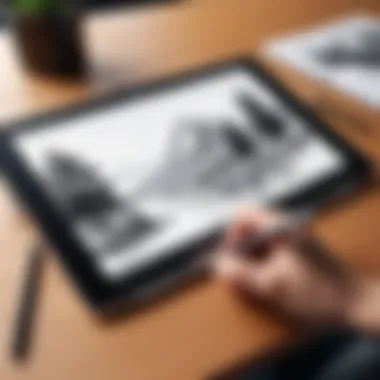
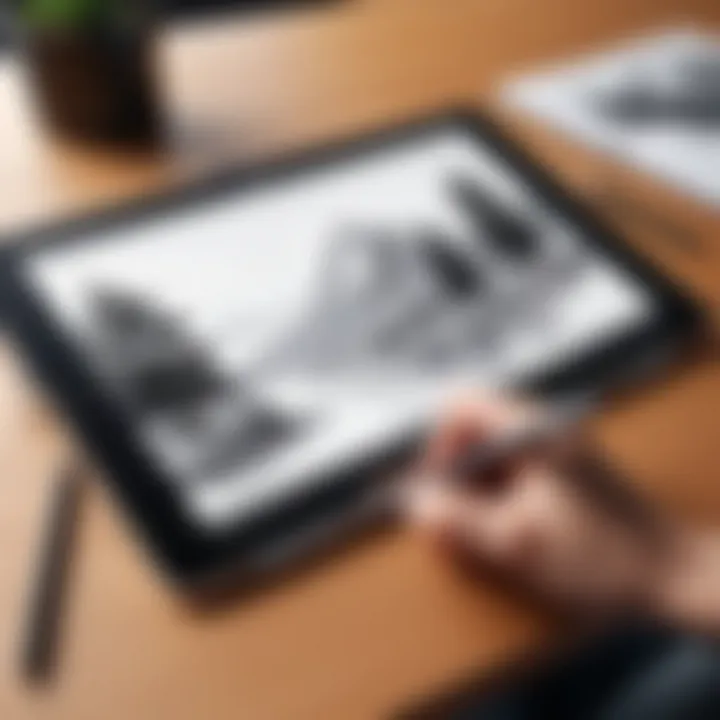
When evaluating these applications, one must consider several key elements such as functionality, target audience, and overall value. The right application can significantly enhance an artist’s workflow and enable more efficient creation processes. Also, understanding the differences between popular sketchbook apps can lead to informed decisions, which can improve the creative experience.
Overview of Leading Applications
Procreate
Procreate stands out as a premier tool for digital sketching on the iPad. Its intuitive interface and powerful features make it a favorite among professional artists and hobbyists alike. One key characteristic of Procreate is its extensive range of brushes and customization options. Users can create custom brushes that suit their unique needs, which fosters a personalized artistic expression.
A unique feature of Procreate is its robust layering system, allowing artists to maintain flexibility in their work. However, this app is exclusively available on iOS, limiting its accessibility to users of other platforms. Procreate remains a leading choice due to its comprehensive toolset and usability.
Adobe Fresco
Adobe Fresco targets users who appreciate the synergy between traditional and digital art. This application blends vector and raster graphics, which is beneficial for artists working in varied styles. A notable characteristic of Adobe Fresco is its Live Brushes, which simulate natural painting effects like watercolors and oils. This feature sets it apart as it caters to those who want a more organic feel in their digital art.
Adobe Fresco’s integration with Adobe Creative Cloud is another advantage, allowing for seamless transitions between different software. However, this can also add complexity for new users who are not already part of the Adobe ecosystem.
Autodesk SketchBook
Autodesk SketchBook is recognized for its user-friendly interface and versatile toolset, appealing to both beginners and seasoned artists. The app’s defining characteristic is its focus on ease of use. This makes it an attractive option for those who prioritize a straightforward drawing experience.
One unique feature of SketchBook is its predictive stroke technology, which enhances line accuracy and reduces drawing errors. This app is available on multiple platforms, including iOS, Android, and desktop, making it highly accessible. However, some users may find that it lacks certain advanced features found in other applications.
Feature Comparisons
Price Point
The price point of sketchbook apps is an important factor that influences user choice. Options like Procreate have a one-time purchase fee, which can be appealing as there are no recurring subscription costs. This approach can be beneficial for users who prefer to manage their creative tools without ongoing financial commitments.
Adobe Fresco operates on a subscription model, providing continuous updates and access to a comprehensive suite of Adobe products. While this ensures that users have access to the latest tools and features, the monthly cost can add up over time.
Autodesk SketchBook has a free version with optional features available through a subscription, offering flexibility for users who want to explore before committing. This pricing structure can cater to a broad audience, enabling beginners to enter the digital art space with minimal upfront costs.
Platform Compatibility
Platform compatibility is key when considering sketchbook apps, as artists often work across devices. Procreate’s exclusivity to iOS may limit its appeal to users who prefer other systems. Conversely, Adobe Fresco offers compatibility across iOS and Windows, appealing to a wider audience.
Autodesk SketchBook’s availability on multiple platforms, including Android, makes it a strong contender for artists who switch between devices or prefer different operating systems. This versatility enhances its usability and ensures accessibility for various users. The ability to work seamlessly across platforms can greatly affect a user's experience and satisfaction with a digital sketching tool.
Advantages of Using Sketchbook Apps
Sketchbook apps have become increasingly popular among artists and designers. Their benefits are significant and deserve attention. These applications provide unique advantages that transform the traditional artistic process.
Portability and Accessibility
One major advantage of sketchbook apps is portability. Artists are no longer restricted to their studio or a specific location. A simple tablet or smartphone can hold a virtual sketchbook. This allows for creative expression in cafes, parks, or while traveling. With a few taps, users can start sketching anywhere. The ease of use encourages spontaneous creativity.
Accessibility is another critical factor. Many sketchbook apps are designed for various devices. Whether it is an iPad or an Android tablet, most software is compatible. This inclusivity means users can choose devices that fit their budget and preferences without sacrificing functionality. Furthermore, many apps also offer cloud storage. Users can save their work online and access it from multiple devices, ensuring their art is always at hand.
Cost-effectiveness Compared to Traditional Materials
Cost considerations play an essential role in the choice of sketching methods. Traditional art materials, like high-quality paper, paint, and brushes, can be expensive. Continuous purchasing can add up, especially for frequent artists. On the other hand, sketchbook apps usually involve a one-time purchase or a subscription fee. This upfront cost allows for the use of numerous tools without separate expenses for each.
Additionally, many sketchbook apps come with free trial periods. This allows users to test their features before committing financially. Artists can experiment with various styles without the risk of wasting physical materials. As a result, transitioning to digital tools can lead to long-term savings.
Environmental Considerations
Environmental impact is a growing concern for many individuals today. Traditional sketching involves using paper, which contributes to deforestation and waste. Sketchbook apps significantly reduce this concern. By using digital tools, artists decrease their carbon footprint. There is no need to consume natural resources for paper or dispose of materials that clutter the environment.
Digital art also allows for endless revisions without adding to waste. Artists can edit and improve their work without discarding drafts. Thus, committing to digital sketching is not only beneficial for personal creativity but also aligns with a more sustainable lifestyle.
"Embracing sketchbook apps means embracing a future where creativity meets environmental responsibility."
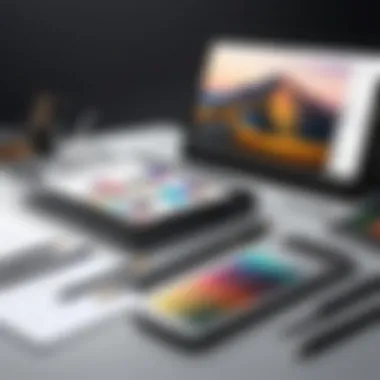
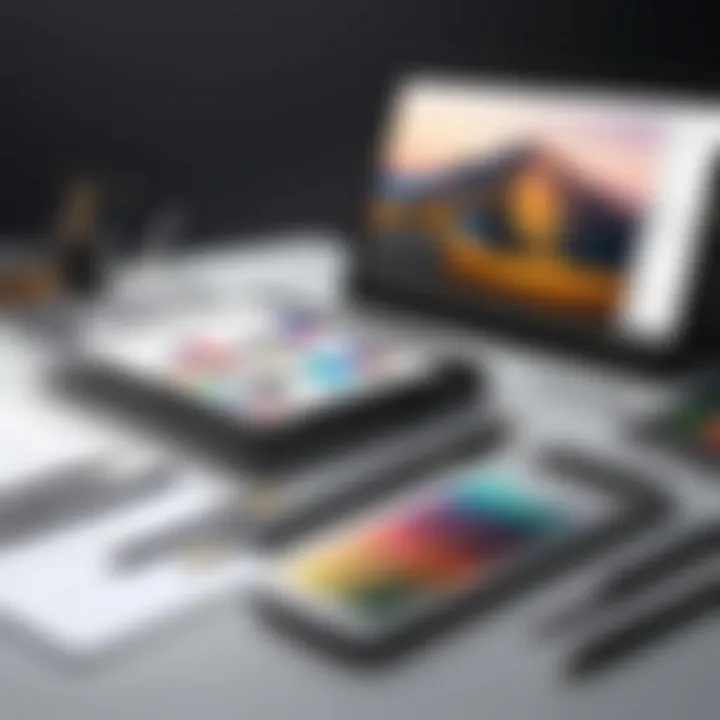
In summary, sketchbook apps offer unparalleled advantages in portability, cost-effectiveness, and environmental sustainability. They are ideal for tech-savvy individuals and early adopters eager to enhance their creative practices. As artists navigate towards digital platforms, these benefits will continue to shape the future of artistic expression.
Challenges Faced by Users
Understanding the challenges faced by users of sketchbook apps is crucial for both developers and creatives. While these applications provide a wealth of tools and functionality, they are not without difficulties. Acknowledging these challenges allows users to improve their experience and can influence future upgrades and features in app development.
Learning Curve for New Users
One of the most significant challenges new users face is the steep learning curve associated with sketchbook apps. Many of these applications incorporate advanced features that can be daunting for beginners. The vast array of tools and settings can lead to confusion, resulting in frustration rather than creativity.
To mitigate this, many developers offer tutorials and user guides, but the effectiveness can vary by app. New users often benefit from a gradual introduction to essential tools before diving into more complex functionalities. Getting accustomed to digital brushes, layers, and interface navigation requires time and practice. \n It is important for apps to provide a user-friendly interface. A well-designed onboarding process helps orient new users and equips them with the knowledge they need to start creating confidently. Understanding this learning curve is vital, as it can vastly affect user retention and satisfaction.
Technical Issues and Bugs
Another problem encountered by users is the presence of technical issues and bugs within sketchbook apps. These problems can disrupt workflow and diminish creative output. Users frequently report bugs such as crashes, sluggish performance, or malfunctioning tools, which can hinder the drawing process.
Apps like Procreate and Adobe Fresco often release updates to address these concerns. However, the frequency and severity of issues can influence user perceptions about app reliability.
"Performance reliability is necessary for users to fully engage with their creative process. A malfunctioning app can lead to lost work and decreased motivation."
Developers must prioritize stability and ease of use to retain users. Feedback mechanisms and user forums can collect insights on common issues, promoting continuous improvement.
Future of Sketchbook Apps
The future of sketchbook apps is a critical area of exploration within digital art. As technology evolves, so too do the tools that creatives rely on. The relevance of sketchbook applications in today's creative landscape cannot be overstated. These programs not only offer artists and designers new ways to express their ideas but also enhance accessibility and functionality.
With the integration of advanced technologies, such as augmented reality and artificial intelligence, sketchbook apps are transforming how creativity is harnessed. Users benefit from unique features that make the artistic process more intuitive and immersive. Understanding these developments is essential for anyone engaged in digital creativity.
Emerging Technologies in Digital Art
Augmented Reality Integration
Augmented reality (AR) integration stands at the forefront of modern sketchbook apps. It allows users to see their digital sketches overlaid on the real world. This functionality enables artists to gain a new perspective on their work, merging the digital and physical spaces seamlessly. The primary characteristic of AR is its ability to visualize concepts in context, which can be invaluable for designers and architects.
A unique feature of AR integration is the capacity to interact with digital elements in a real environment. This interactivity provides numerous advantages, such as enhanced creativity and the opportunity for more comprehensive feedback from peers without intricate setups. Nevertheless, there are disadvantages; for instance, not all devices support extensive AR features, limiting accessibility for some users.
Artificial Intelligence Assistance
Artificial intelligence (AI) assistance represents another innovative approach in sketchbook apps. This technology can analyze user behavior, offering tailored suggestions to enhance creativity and workflow. The significance of AI lies in its ability to learn from the user's artistic style, making it easier to create unique pieces.
AI's unique feature includes smart brush settings that adapt based on user input, adjusting thickness or opacity in real-time. This can speed up the creative process and help artists focus more on their vision rather than technical details. Although AI can offer substantial support, some users might perceive a loss of personal touch in their creations, which is a valid concern in a field that deeply values individuality.
Anticipated Trends in User Features
The anticipated trends in user features further illustrate the shift towards more user-centric design in sketchbook apps. Users are seeking more customization and personalized experiences within these applications. Potential developments may include enhanced cloud storage options for collaboration, real-time sharing features, and more adaptable interfaces.
These trends are indicative of a broader shift towards inclusivity and community-building in digital art spaces. As more features cater to a diverse range of artistic styles and preferences, the potential for richer creative experiences will only increase, ensuring the relevance of sketchbook apps in the digital age.
Ending
In the digital age, sketchbook apps have emerged as an essential tool for artists and designers, remarkably transforming the traditional methods of sketching. The significance of these applications extends beyond mere convenience; they offer unique functionalities that enhance the creative process. Artists can easily carry an extensive suite of tools without the burden of physical materials. Furthermore, the integration of technology in creative practices fosters innovation, encouraging experimentation and broadening artistic expression.
Recap of Key Insights
Throughout this article, several key insights about sketchbook apps have been discussed. First, it is crucial to understand the definition and historical context of digital sketching to appreciate its evolution. The user requirements are diverse, catering to various target audiences including hobbyists, serious artists, and designers. This diversity has driven the development of multiple applications tailored to different needs.
The analysis of the key features highlighted the importance of digital toolsets and user interfaces that facilitate seamless navigation and customization. Popular applications such as Procreate, Adobe Fresco, and Autodesk SketchBook were evaluated in terms of their advantages and limitations, helping potential users to make informed decisions.
Finally, we looked at the benefits, such as portability and cost-effectiveness, while not shying away from the challenges users face, including technical issues and a learning curve. Overall, understanding these elements empowers artists, helping them adapt to the evolving landscape of digital art.
Final Thoughts on Digital Sketching Trends
Looking into the future, the potential developments in sketchbook apps are exciting. Emerging technologies like augmented reality and artificial intelligence are poised to further enhance the digital drawing experience. These innovations may provide artists with tools to visualize their ideas in new ways and automate repetitive tasks, thus streamlining the creative workflow.
It is also essential to anticipate user trends, as artists increasingly seek smarter tools that cater to their specific needs. As creativity continues to intertwine with technology, the possibilities for artistic expression are bound to expand.
In essence, the future of sketchbook apps lies in their ability to adapt to user demands and technological advancements, making them indispensable in the arsenal of modern creators.







